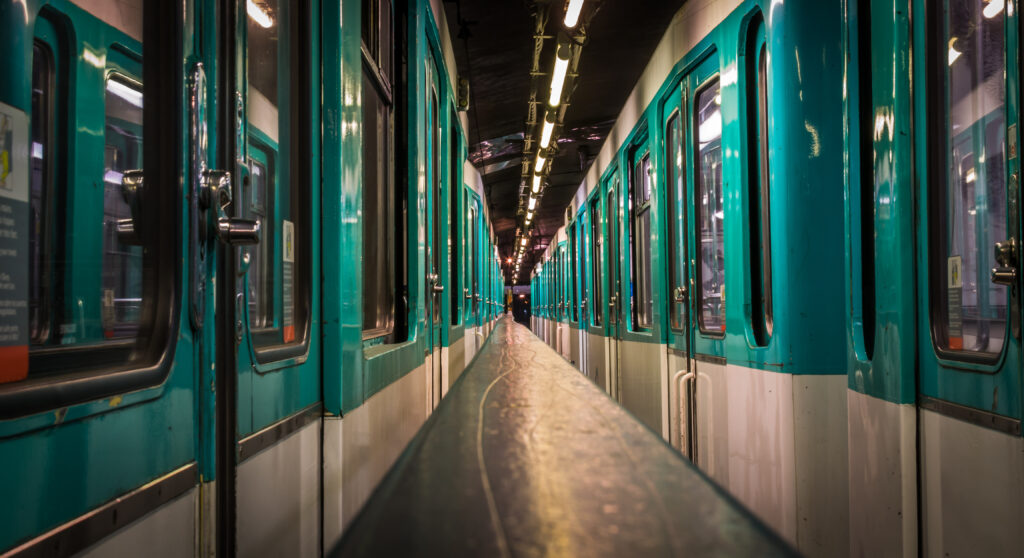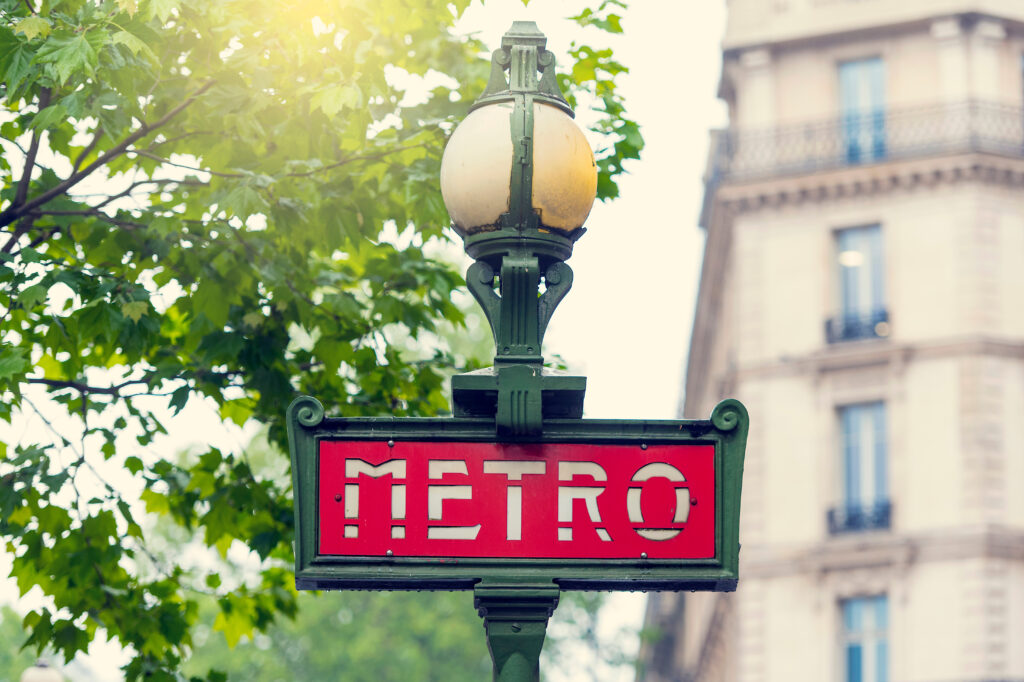
Paris has hundreds of metro stations, but some have remained closed to the public for ever. Whether relics of the past or urban curiosities, these ghost stations are as fascinating as they are intriguing. Some never opened, like Haxo or Porte Molitor, while others, like Arsenal or Saint-Martin, were in operation for a few years before disappearing from the map for good. Still others, such as Martin Nadaud or Croix-Rouge, have found a second life as corridors, film sets or artistic spaces.
In this article, we take you on an unusual journey through 13 ghostly stations in the Paris metro, with their forgotten stories, secret architecture and surprising anecdotes.
1. Haxo station in the 19th arrondissement, where no passenger has ever been

Do you know Haxo station? If you haven't, it's normal: it's never opened its doors! Located under boulevard Sérurier, in the 19ᵉ arrondissement, it was originally intended to link line 3 bis to Porte des Lilas and line 7 bis to Pré Saint-Gervais. At the time, the Compagnie du chemin de fer métropolitain de Paris was not in favour of its construction. But the City of Paris, which owned the network, launched the project anyway. It was a miscalculation: the work was never completed, no external access was built and the station was never connected to the surface. To this day, under the Boulevard Sérurier, there remains this ghost station, built but never opened to the public, where no passenger has ever passed.
2. Porte Molitor, in the south-west: a siding for lines 9 and 10 trains
Like Haxo station, Porte Molitor station (on lines 9 and 10) has never welcomed passengers and is one of the ghost stations of the Paris metro. Built in 1923 in the 16ᵉ arrondissement, it was originally intended to serve the Parc des Princes on match nights. But the project soon proved unfeasible: access from the street was never built, deemed too narrow and unsuitable to accommodate the expected crowds. As a result, the station remained closed to the public. Today, Porte Molitor is not completely useless: it serves as a siding for trains on lines 9 and 10.
See also our article Top 13 unusual hotels to try in Paris.
3. Arsenal, on line 5: used by the RATP as a training centre

Arsenal station, on line 5, opened in 1906 but closed to passengers at the start of the Second World War. Located between Bastille and Quai de la Rapée, it even made an appearance in the cinema, notably in La Grosse Caisse (1965) with Bourvil. In 1939, some of the metro's staff were mobilised, leading to a reduction in service. After the Liberation, Arsenal was deemed too close to its neighbouring stations and was never reopened to the public. Today, although it no longer appears on network maps, the station still exists: it is now used by RATP as a training centre for its electrical technicians and engineers.
Looking for something unusual? Check out our article Top 11 of the best unusual restaurants in Paris.
4. Champ-de-Mars, on line 8: missing from the metro map and one of the ghost stations of the Paris metro
Champ-de-Mars station, on line 8, opened in 1913 but soon suffered from a lack of use. Located between La Motte-Picquet-Grenelle (already served by three lines) and École Militaire, it was deemed too close to its neighbours to be profitable. In September 1939, on the eve of the Second World War, the station closed. Unlike other stations, it never reopened. In the 1970s, it even disappeared completely from the metro map. Today, only a discreet trace of this ghost station remains: one of its former entrances has been converted into a fan to cool the underground.
Read the article: Top 15 unusual activities to try in Paris
5. Croix-Rouge, on line 10: used as a backdrop for an Étienne Daho music video

Croix-Rouge station, on line 10, was opened in 1923. Located in the 6ᵉ arrondissement, between Sèvres-Babylone and Mabillon, it served as a temporary terminus for the line. But in 1939, judged to be too close to Sèvres-Babylone, it closed its doors to passengers. Since then, line 10 trains have always passed through without stopping. However, the station has had a second life: used as a backdrop for advertisements, film shoots - including an Étienne Daho video - and even transformed into a temporary beach with deckchairs during an artistic installation in the 1980s. More recently, in 2019, a conversion project was imagined: the station could have become a restaurant called Terminus. But for technical reasons, this idea never came to fruition.
An activity that might interest you: Take a guided tour of Paris on ghosts, legends and mysteries by booking here and discover the dark and secret side of the City of Light.
6. Saint-Martin, at the junction of line 8 and line 9

Saint-Martin station, on lines 8 and 9, operated briefly between 1932 and 1939 before closing for good. Located between Strasbourg-Saint-Denis and République, it was deemed too close to its neighbour Strasbourg-Saint-Denis and therefore did not reopen after the Second World War. Despite its closure, the station has found other uses. In particular, its 440 m² underground was used for advertising purposes. In 2010, during the Nuit Blanche, Saint-Martin even exceptionally reopened its doors to host an artistic creation devised by the École nationale supérieure des arts décoratifs.
7. Martin Nadaud station in the 20th arrondissement of Paris
Among the stations that have opened and then closed is Martin Nadaud, in the 20ᵉ arrondissement, one of the ghost stations of the Paris metro. It was the former terminus of line 3 between 1905 and 1921. In 1969, during the remodelling of Gambetta station, Martin Nadaud was absorbed into the latter and ceased to receive passengers for good. Two years later, in 1971, it even became a simple corridor within Gambetta. Today, the station's former entrance is still used as an exit onto Place Martin Nadaud.
An activity that might interest you: this haunted guided tour of Père-Lachaise cemetery, where you can see the tombs of celebrities and listen to fascinating stories about the cemetery's ghosts.
8. Invalides station (line 8): a "half-station" among the ghostly stations of the Paris metro
Some open stations have "dead" platforms, meaning they are inaccessible to the public. This is the case at Invalides on lines 8 and 13. Few passengers know it, but part of the platform towards Balard is never used. When it was built, this platform was intended to accommodate a future circular line that never saw the light of day. As a result, this part of the station has never seen a single passenger, making Invalides a sort of ghost "half-station" in the heart of a station that is still very much alive.
An activity that might interest you: Discover the secrets and mysteries of Père Lachaise cemetery by booking this captivating guided tour led by a professional actor. And don't forget: if you yawn, you'll get your money back! Are you up for the challenge?
9. Porte des Lilas station, a film and TV location

Among the open stations with a "dead" platform, Porte des Lilas is undoubtedly the most famous of the Paris metro's ghost stations. Opened on 27 November 1921 as the terminus of line 3 from Porte de Champerret, it then operated a shuttle service from Pré-Saint-Gervais to Porte des Lilas until 1939. Today, this unused platform is attracting attention for other reasons: for several years it has been used as a film set for cinema and television, appearing in films such as Ronin, Le Fabuleux Destin d'Amélie Poulain and Les Femmes de l'ombre.
Activity that might interest you: Venture to the dark side of Paris and explore the city's most sinister locations by booking this evening guided walking tour. Discover the murders, crimes and legends that have marked the history of Paris.
10. Gare du Nord station (lines 4 and 5): a training centre for RATP drivers
Even one of the busiest stations in Paris, Gare du Nord (lines 4 and 5), has its share of ghosts. The old station, which served as a loop terminus for line 5, was replaced in 1942 when the line was extended to Porte de Pantin. A new station was then built at rue du Faubourg Saint-Denis, leaving the old one out of service for passengers. Today, this ghost station is not completely abandoned: it serves as a training centre for RATP drivers, with several dummy signals installed along the track.
11. Porte Maillot station: one of the Paris metro's ghost stations

Few passengers know it, but Porte Maillot was the first terminus of line 1, opened in 1900. Built in a loop at the same level as the Petite Ceinture line, this station prevented any future extensions. In 1936, to allow extension to the Pont de Neuilly, a new, deeper station was built a little further along, while the old platforms were retained. Today, Porte Maillot still exists, but its position has changed slightly since its creation. The former terminus was transformed into a reception area by the RATP in the 1990s, and since 2007 the platform has been used as a loading platform for the driverless trains on line 1.
12. Victor Hugo station, still visible to line 2 passengers

This is one of the Paris metro's ghost stations. Originally opened in 1900, the station was too curved to be used safely with the new trains of the time. It was therefore rebuilt a few metres further on in 1931. The old station, now completely abandoned, is still visible to passengers on line 2 who cross it without stopping.
13. The old Porte de Versailles station, no longer there
Porte de Versailles station was also moved in 1930 to allow line 12 to be extended to Mairie d'Issy. The old station has now disappeared, making way for the tracks now used to park trains.
See also the most popular things to do in Paris:


